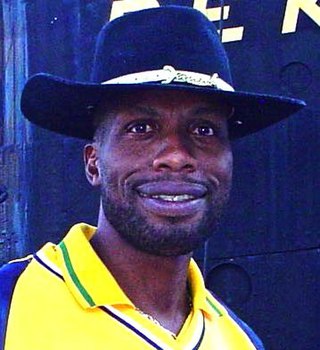
Sir Curtly Elconn Lynwall Ambrose KCN is an Antiguan former cricketer who played 98 Test matches for the West Indies. Widely acknowledged as one of the greatest fast bowlers of all time, he took 405 Test wickets at an average of 20.99 and topped the ICC Player Rankings for much of his career to be rated the best bowler in the world. His great height—he is 6 feet 7 inches (2.01 m) tall—allowed him to make the ball bounce unusually high after he delivered it; allied to his pace and accuracy, it made him a very difficult bowler for batsmen to face. A man of few words during his career, he was notoriously reluctant to speak to journalists. He was chosen as one of the Wisden Cricketers of the Year in 1992; after he retired he was entered into the International Cricket Council Hall of Fame and selected as one of West Indies all-time XI by a panel of experts.
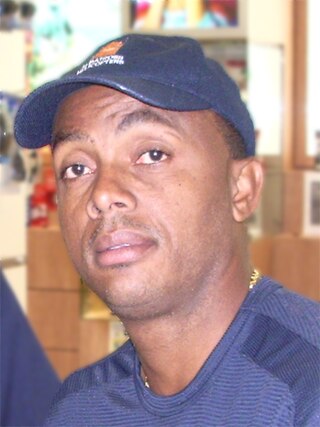
Courtney Andrew Walsh OJ is a former Jamaican cricketer who represented the West Indies from 1984 to 2001, captaining the West Indies in 22 Test matches. He is a fast bowler and considered one of the all-time greats, best known for a remarkable opening bowling partnership along with fellow West Indian Curtly Ambrose for several years. Walsh played 132 Tests and 205 ODIs for the West Indies and took 519 and 227 wickets respectively. He shared 421 Test wickets with Ambrose in 49 matches. He held the record of most Test wickets from 2000, after he broke the record of Kapil Dev. This record was later broken in 2004 by Shane Warne. He was the first bowler to reach 500 wickets in Test cricket. His autobiography is entitled "Heart of the Lion". Walsh was named one of the Wisden Cricketers of the Year in 1987. In October 2010, he was inducted into the ICC Cricket Hall of Fame. He was appointed as the Specialist Bowling Coach of Bangladesh Cricket Team in August 2016.
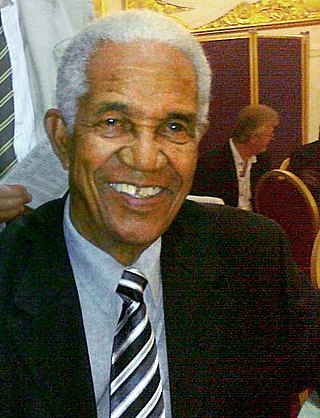
Sir Garfield St Aubrun Sobers,, also known as Sir Gary or Sir Garry Sobers, is a former cricketer who played for the West Indies between 1954 and 1974. A highly skilled bowler, an aggressive batsman and an excellent fielder, he is widely considered to be cricket's greatest ever all-rounder and one of the greatest cricketers of all time.
Malcolm Denzil Marshall was a Barbadian cricketer. Primarily a fast bowler, Marshall is widely regarded as one of the greatest and one of the most accomplished fast bowlers of the modern era in Test cricket. He is often acknowledged as the greatest West Indian fast bowler of all time, and certainly one of the most complete fast bowlers the cricketing world ever saw. His Test bowling average of 20.94 is the best of anyone who has taken 200 or more wickets. He achieved his bowling success despite being, by the standards of other fast bowlers of his time, a short man – he stood at 180 cm, while most of the great quicks have been well above 183 cm and many great West Indian fast bowlers, such as Joel Garner, Curtly Ambrose and Courtney Walsh, were 197 cm or above. He generated fearsome pace from his bowling action, with a dangerous bouncer. He also statistically went on to become the most successful test match bowler of the 1980s with 235 scalps with an average of 18.47 within a time period of just five years. Marshall was a part of the West Indies team that reached the 1983 Cricket World Cup Final, but lost to India by 43 runs.

Hedley Verity was a professional cricketer who played for Yorkshire and England between 1930 and 1939. A slow left-arm orthodox bowler, he took 1,956 wickets in first-class cricket at an average of 14.90 and 144 wickets in 40 Tests at an average of 24.37. Named as one of the Wisden Cricketers of the Year in 1932, he is regarded as one of the most effective slow left-arm bowlers to have played cricket. Never someone who spun the ball sharply, he achieved success through the accuracy of his bowling. On pitches which made batting difficult, particularly ones affected by rain, he could be almost impossible to bat against.
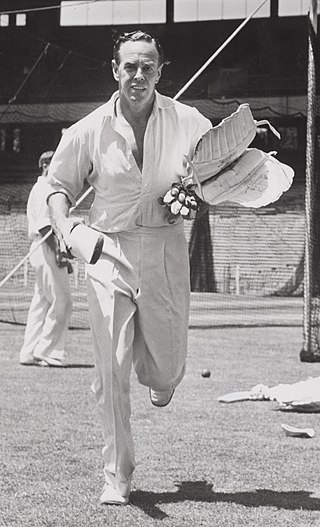
Ian William Geddes Johnson, was an Australian cricketer who played 45 Test matches as a slow off-break bowler between 1946 and 1956. Johnson captured 109 Test wickets at an average of 29.19 runs per wicket and as a capable lower order batsman made 1,000 runs at an average of 18.51 runs per dismissal. He captained the Australian team in 17 Tests, winning seven and losing five, with a further five drawn. Despite this record, he is better known as the captain who lost consecutive Ashes series against England. Urbane, well-spoken and popular with his opponents and the public, he was seen by his teammates as a disciplinarian and his natural optimism was often seen as naive.

Fazal Mahmood PP, HI was a Pakistani international cricketer. He played in 34 Test matches and took 139 wickets at a bowling average of 24.70. The first Pakistani to pass 100 wickets, he reached the landmark in his 22nd match.
Lancelot Richard Gibbs is a former West Indies cricketer, one of the most successful spin bowlers in Test cricket history. He took 309 Test wickets, only the second player to pass 300, the first spinner to pass that milestone, and had an exceptional economy rate of under two runs per over.

The Wisden Trophy was awarded to the winner of the Test cricket series played between England and the West Indies. It was first awarded in 1963 to commemorate the hundredth edition of Wisden Cricketers' Almanack. Series were played in accordance with the future tours programme, with varying lengths of time between tours. If a series was drawn then the country holding the Wisden Trophy retained it. In 2020, it was announced that the trophy would be replaced by the Richards–Botham Trophy named after Sir Vivian Richards and Sir Ian Botham.
Seymour MacDonald Nurse was a Barbadian cricketer. Nurse played 29 Test matches for the West Indies between 1960 and 1969. A powerfully built right-hand batsman and an aggressive, if somewhat impetuous, shotmaker, Nurse preferred to bat in the middle order but was often asked to open the batting. A relative latecomer to high-level cricket, Nurse's Test cricket career came to what many consider a premature end in 1969.

Douglas Thomas Ring was an Australian cricketer who played for Victoria and for Australia in 13 Test matches between 1948 and 1953. In 129 first-class cricket matches, he took 426 wickets bowling leg spin, and he had a top score of 145 runs, which was the only century of his career.
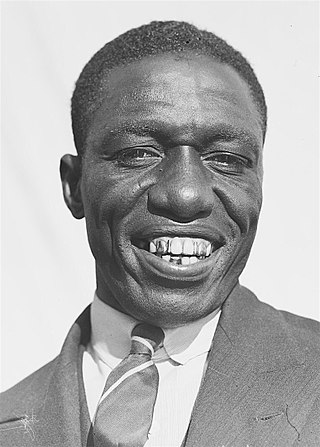
George Nathaniel Francis was a West Indian cricketer who played in West Indies' first Test in their inaugural Test tour of England. He was a fast bowler of renowned pace and was notably successful on West Indies' non-Test playing tour of England in 1923, but he was probably past his peak by the time the West Indies were elevated to Test status. He was born in Trents, St. James, Barbados and died at Black Rock, Saint Michael, also in Barbados.

Joseph A. Small was a West Indian cricketer who played in West Indies' first Test in their inaugural Test tour of England. He scored the first half century for a West Indies player in Test cricket and played two further Test matches in his career. An all-rounder, he played domestic cricket for Trinidad between 1909 and 1932.
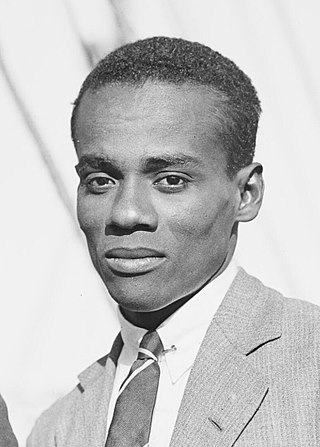
Edwin Lloyd St Hill was a Trinidadian cricketer who played two Test matches for the West Indies in 1930. His brothers, Wilton and Cyl, also played for Trinidad and Tobago; in addition, the former played Test matches for the West Indies. St Hill first played local cricket in with some success and graduated to the Trinidad and Tobago team. He played regularly for the next five years but was not selected for any representative West Indian teams. His increased success in 1929 attracted the attention of the West Indies selectors, and he played two Test matches against England in 1930. Although not particularly successful, he bowled steadily and was chosen to tour Australia with the West Indies in 1930–31. He was fairly effective in first-class games but the form of the other fast bowlers in the team meant that he was not chosen for any of the Test matches.

Emmanuel Alfred Martindale was a West Indian cricketer who played in ten Test matches from 1933 to 1939. He was a right-arm fast bowler with a long run up; although not tall for a bowler of his type he bowled at a fast pace. With Learie Constantine, Martindale was one of the earliest in the long succession of Test-playing West Indian fast bowlers. During the time he played, the West Indies bowling attack depended largely on his success. Critics believe that his record and performances stand comparison with bowlers of greater reputation and longer careers.
The English cricket team in the West Indies in 1934–35 was a cricket touring party sent to the West Indies under the auspices of the Marylebone Cricket Club for a tour lasting 2+1⁄2 months in 1934–35. The team played four Test matches against the West Indian cricket team, winning one match but losing two – the first series defeat of an English side by the West Indies.
The English cricket team in the West Indies in 1959–60 played five Test matches, eight other first-class matches and two minor games. England won the Test series by one match to nil, with the other four matches being drawn.
The West Indies cricket team toured England in 1933, playing three Test matches, losing two of them and drawing the other. In all, the side played 30 first-class matches, winning only five and losing nine.

George Alphonso Headley OD, MBE was a West Indian cricketer who played 22 Test matches, mostly before World War II. Considered one of the best batsmen to play for the West Indies and one of the greatest cricketers of all time, Headley also represented Jamaica and played professional club cricket in England. West Indies had a weak cricket team through most of Headley's playing career; as their one world-class player, he carried a heavy responsibility and the side depended on his batting. He batted at number three, scoring 2,190 runs in Tests at an average of 60.83, and 9,921 runs in all first-class matches at an average of 69.86. He was chosen as one of the Wisden Cricketers of the Year in 1934.













